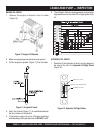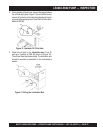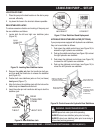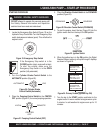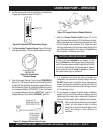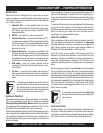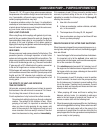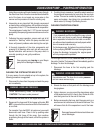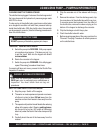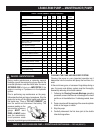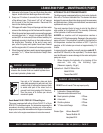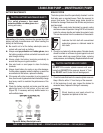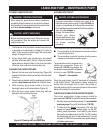
PAGE 32 — MAYCO LS400/LS500 PUMP — OPERATION AND PARTS MANUAL — REV. #6 (09/19/11)
It is strongly recommended that
steel pipe
be used on all vertical pumping for safety and
convenience.
When pumping is resumed, you can expect blockage at the
point of hose collapse. To prevent this from happening, the
hose can be “kinked off” at the discharge end when the pump
is stopped to prevent the gravity flow of the material in the
hose.
The use of stiffer mixes when pumping downhill will decrease
gravity flow of the material in the hose and will assure a
smoother operation between the cam roller bearing and cam
plate. As with any job, make sure that the hose and the
couplings are in good workable shape.
VERTICAL PUMPING
When pumping vertically up the side of a building, above 40
feet, we would recommend the installation of
steel pipe
securely fastened at intervals as necessary to support the
pipe. Ninety degree, long radius pipe sweeps should be
installed at the top and bottom of the steel line.
Use a 25 ft. hose, or short section, off the pump; and for the
balance of the horizontal distance to the vertical line, use
steel pipe. This type of installation has been satisfactory on
many jobs being pumped in excess of 100 feet high. Line
pressures are always less using steel pipe as compared to
hose.
When pumping vertically, using
all hose
, it is recommended
not to go higher than 50 feet with hose. The hose should be
tied off at intervals of 10 feet, if possible. Special attention
should be given when tieing the hose off at the top as the hose
will have a tendency to stretch when filled with concrete. This
will increase the possibility of a blockage at the point where
the hose is tied off. To avoid this, a long radius of 90º elbow
is recommended. The suggested place to tie off is on the
hose, under the clamp.
LS400/LS500 PUMP — PUMPING INFORMATION
All admixtures will be shown on the redi-mix
concrete ticket. Before starting the pumping
job, ask the driver of the redi-mix truck to see
the concrete ticket and note the admixtures
that exist and take the proper action.
REMIXTURES
Remixtures that are designed into the concrete mix by the
redi-mix company or an architectural engineering company.
This section lists common admixtures and a brief explana-
tion of their functions:
A. Pozzolith 300 – or the equivalent acts as a water
retarder and a lubricant. On a lean mix, long pushes,
stiff mixes, and vertical pushes, Pozzolith 300R
helps pumpability.
B. MBVR – air entraining, acts as a lubricant.
C. Calcium Chloride – commonly referred to as C.C.,
is used as an accelerator. When pumping a load with
calcium chloride, it is recommended that you wash
out if the waiting time between delivery trucks
becomes too long.
D. Super Plasticizers – acts as an accelerator. The
concrete will look very wet after the super plasticizer
is added, but will begin to set up very fast. Wash out
immediately if you do not have a truck waiting. Super
plasticizers are used mainly on commercial jobs.
E. Red Label – acts as a water retarder and an
accelerator. Red label will be used mainly on com-
mercial jobs.
F. Fly Ash – is used to help increase the strength of
the concrete and decrease the cement content per
yard. This is one of the most common admixtures
used.
DOWNHILL PUMPING
Downhill pumping can be a difficult procedure on some jobs.
The slurry procedure would be the same as explained
Priming The Pump With Slurry Mixture
section of this manual.
It is suggested that a sponge approximately 2”x 4”x 6” in size
be placed in the hose before the start of pumping.
Wet the sponge before placing it in the hose to keep the slurry
from running too far ahead of the concrete, which will reduce
the possibility of separation. When the pump is stopped, the
material can flow slowly down, due to gravity, and cause the
hose to collapse.
HOSE PULSATION
A slight pulsation of the hose will always be noticeable near
the pump. Excessive pulsation of the hose near the pump is
normally due to higher than average line pressures caused by
stiff, harsh mixes, or extremely long pumping distances.



